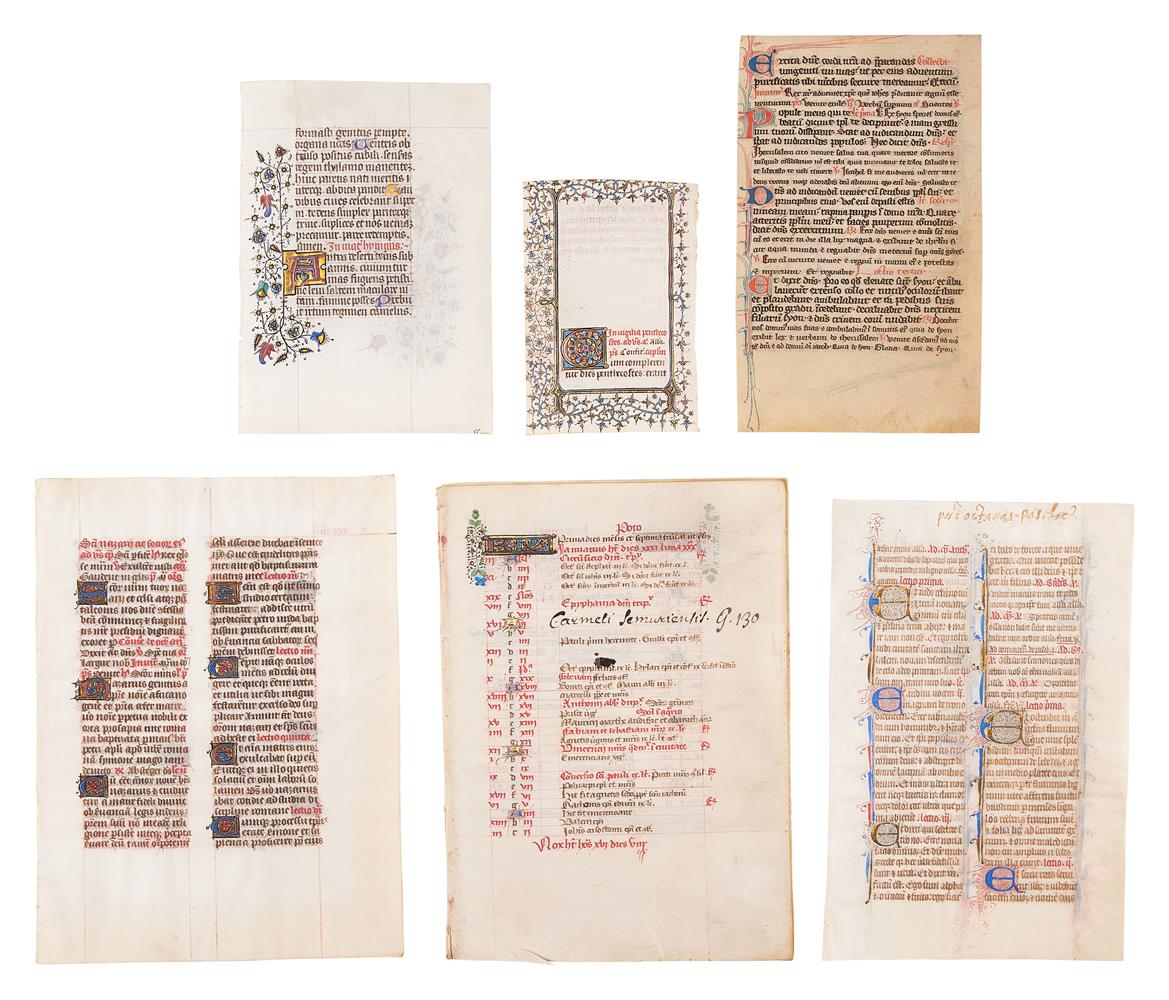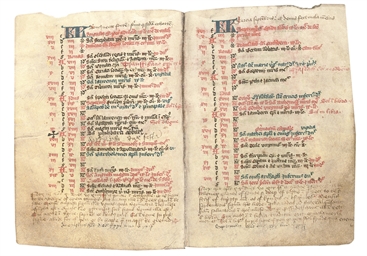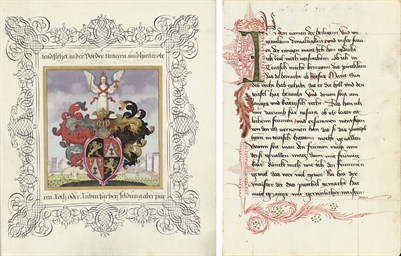BREVIARY, in Latin, DECORATED MANUSCRIPT ON VELLUM [Bodensee (Lake Constance), 14th century] 126 x 85mm. 415 leaves, early foliation on versos running from the sixth leaf i-ccccv, the inserted leaf after f.lxxxvi not foliated: 1 5(of 6, lacking i), 2-8 1 2, 9 1 3(of 12 + iii inserted singleton), 10-20 1 2, 21 8, 22-29 8(of 12, lacking ix-xii), 30 2, 31-35 1 2, 36 1 1(?of 12 +i-ii, lacking x-xii), 37 8(early addition, of 12 lacking i-iv), catchwords in lower margins of some final versos, 26 lines written in black ink in a gothic bookhand between two verticals and 29 horizontals ruled in brown, pricking for horizontals, justification: 93 x 60mm, rubrics in red, large flourished initials in red and blue, two-line initials alternately in red flourished with blue and blue flourished with red, one-line initials alternately in red and blue, one full and one partial border in red and blue; pastedowns cut from a 14th-century commentary on the Decretals , with red and blue paragraph marks and a red heading on the upper cover for Book III, xxx, on tithes (early repairs and annotations, some leaves cut or torn, some initials excised, some water damage especially in latter part of book, margins worn, fading of some text). German 16th-century vellum over pasteboard with central metal bosses, two replacement straps with metal clasps to pins on lower cover (rubbed, split to upper joint, lacking part of one clasp). PROVENANCE: The breviary was probably written for the use of the great Benedictine abbey of Reichenau, in Latin Augia or Augia dives since the dedication of augien [ sis ] ecc [ lesi ] e appears in the Calendar for 22 June, with octave. The dedication of the chapel of Sts Faith and Elizabeth is given on the following day. There were three churches on the monastery island of Reichenau: the main church, dedicated to the Virgin, is presumably indicated here. Since St Pirmin, the founder of Reichenau in 724, appears only as an addition on 3 November, it is possible that another Augia or island is meant, although the name unqualified is most probably intended for the oldest and most famous foundation, that of Reichenau. The Benedictine Abbey of Augia Maior or Brigantina , near Bregenz, for instance, is also in the Bodensee region indicated by the Calendar: in red are Ulric (Odalric), Bishop of Augsburg, educated at St Gall (4 July); Othmar, first abbot of St Gall (16 November); Conrad, Bishop of Constance (26 November); in black are Felix and Regula (11 September) and Florinus (17 November). St Gall is invoked in the litany. Other local saints were added to the Calendar along with Pirmin, among them Fridolin (6 March) and Lucius (9 October). The various annotations and additions show that the breviary continued in use in the area for which it was made. The feast of Corpus Christi, instituted for the whole church in 1264, rapidly gained in popularity during the 14th century. CONTENT: Calendar (lacking January and February), first five folios; Psalter with canticles and litany ff.i-xlviii; Temporal ff.xlix-ccxxv; collects ff.ccxxv-ccxxvii; dedication of church ff.ccxxvii-ccxxxi; Sanctoral, with added lists of capitula on f.ccclxvii, which with the following leaf was originally left blank, perhaps because of tears, ff.ccxxxi-ccclxxvi; Communal, followed by offices for the 11,000 Virgins and St Francis ff.ccclxxvi-ccclxxxxvi; various capitula and hymns, lacking end, ff.ccclxxxxvi-ccccv; added office for Corpus Christi final seven leaves. The Breviary contains the offices that the clergy had to recite at the liturgical hours on every day throughout the year, a complex cycle of changing celebrations. Although some lay people used the breviary, the provenance of the present lot and its extensive annotations suggest that it was used by clerics. An unostentatious book for daily use, it was, however, very possibly produced in the same scriptorium as the magnificent Ottonian codices for which Reichenau is famed. The contrast poignantly expres
BREVIARY, in Latin, DECORATED MANUSCRIPT ON VELLUM [Bodensee (Lake Constance), 14th century] 126 x 85mm. 415 leaves, early foliation on versos running from the sixth leaf i-ccccv, the inserted leaf after f.lxxxvi not foliated: 1 5(of 6, lacking i), 2-8 1 2, 9 1 3(of 12 + iii inserted singleton), 10-20 1 2, 21 8, 22-29 8(of 12, lacking ix-xii), 30 2, 31-35 1 2, 36 1 1(?of 12 +i-ii, lacking x-xii), 37 8(early addition, of 12 lacking i-iv), catchwords in lower margins of some final versos, 26 lines written in black ink in a gothic bookhand between two verticals and 29 horizontals ruled in brown, pricking for horizontals, justification: 93 x 60mm, rubrics in red, large flourished initials in red and blue, two-line initials alternately in red flourished with blue and blue flourished with red, one-line initials alternately in red and blue, one full and one partial border in red and blue; pastedowns cut from a 14th-century commentary on the Decretals , with red and blue paragraph marks and a red heading on the upper cover for Book III, xxx, on tithes (early repairs and annotations, some leaves cut or torn, some initials excised, some water damage especially in latter part of book, margins worn, fading of some text). German 16th-century vellum over pasteboard with central metal bosses, two replacement straps with metal clasps to pins on lower cover (rubbed, split to upper joint, lacking part of one clasp). PROVENANCE: The breviary was probably written for the use of the great Benedictine abbey of Reichenau, in Latin Augia or Augia dives since the dedication of augien [ sis ] ecc [ lesi ] e appears in the Calendar for 22 June, with octave. The dedication of the chapel of Sts Faith and Elizabeth is given on the following day. There were three churches on the monastery island of Reichenau: the main church, dedicated to the Virgin, is presumably indicated here. Since St Pirmin, the founder of Reichenau in 724, appears only as an addition on 3 November, it is possible that another Augia or island is meant, although the name unqualified is most probably intended for the oldest and most famous foundation, that of Reichenau. The Benedictine Abbey of Augia Maior or Brigantina , near Bregenz, for instance, is also in the Bodensee region indicated by the Calendar: in red are Ulric (Odalric), Bishop of Augsburg, educated at St Gall (4 July); Othmar, first abbot of St Gall (16 November); Conrad, Bishop of Constance (26 November); in black are Felix and Regula (11 September) and Florinus (17 November). St Gall is invoked in the litany. Other local saints were added to the Calendar along with Pirmin, among them Fridolin (6 March) and Lucius (9 October). The various annotations and additions show that the breviary continued in use in the area for which it was made. The feast of Corpus Christi, instituted for the whole church in 1264, rapidly gained in popularity during the 14th century. CONTENT: Calendar (lacking January and February), first five folios; Psalter with canticles and litany ff.i-xlviii; Temporal ff.xlix-ccxxv; collects ff.ccxxv-ccxxvii; dedication of church ff.ccxxvii-ccxxxi; Sanctoral, with added lists of capitula on f.ccclxvii, which with the following leaf was originally left blank, perhaps because of tears, ff.ccxxxi-ccclxxvi; Communal, followed by offices for the 11,000 Virgins and St Francis ff.ccclxxvi-ccclxxxxvi; various capitula and hymns, lacking end, ff.ccclxxxxvi-ccccv; added office for Corpus Christi final seven leaves. The Breviary contains the offices that the clergy had to recite at the liturgical hours on every day throughout the year, a complex cycle of changing celebrations. Although some lay people used the breviary, the provenance of the present lot and its extensive annotations suggest that it was used by clerics. An unostentatious book for daily use, it was, however, very possibly produced in the same scriptorium as the magnificent Ottonian codices for which Reichenau is famed. The contrast poignantly expres



.jpg)








Testen Sie LotSearch und seine Premium-Features 7 Tage - ohne Kosten!
Lassen Sie sich automatisch über neue Objekte in kommenden Auktionen benachrichtigen.
Suchauftrag anlegen